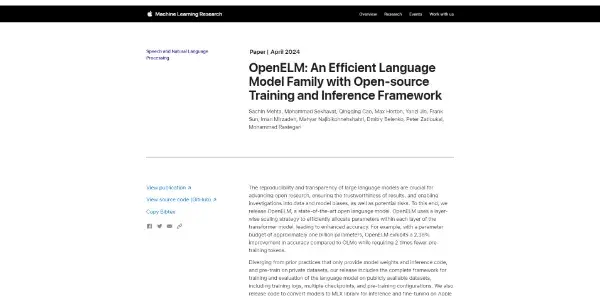OpenELM by Apple

Powerful open-source LLM models designed by Apple directly on your devices, without the cloud. Trained with evolutionary algorithms for maximum accuracy
OpenELM: Apple's On-Device Large Language Model
Apple's foray into the world of open-source AI has yielded OpenELM, a powerful suite of Large Language Models (LLMs) designed to run directly on your Apple devices. Unlike many cloud-based LLMs, OpenELM leverages the processing power of your local hardware, eliminating concerns about data privacy, latency, and internet connectivity. This article explores OpenELM's capabilities, features, applications, and its position within the broader LLM landscape.
What OpenELM Does
OpenELM provides a set of on-device LLM models capable of performing various natural language processing tasks. These models, trained using evolutionary algorithms, are optimized for accuracy and efficiency on Apple's silicon. The core functionality includes:
- Text generation: Creating coherent and contextually relevant text based on given prompts.
- Text summarization: Condensing lengthy texts into concise summaries.
- Question answering: Providing accurate answers to questions posed in natural language.
- Translation: Converting text between different languages.
- Sentiment analysis: Determining the emotional tone of a piece of text.
Main Features and Benefits
The key features and benefits of OpenELM stem from its on-device architecture:
- Privacy: Your data remains entirely on your device, ensuring enhanced privacy and security. No data is transmitted to external servers.
- Offline functionality: OpenELM works without an internet connection, making it reliable in areas with limited or no connectivity.
- Speed and low latency: Processing occurs locally, resulting in significantly faster response times compared to cloud-based alternatives.
- Accessibility: Open-source nature allows for community contributions and customizations. Developers can integrate OpenELM into their applications more easily.
- Accuracy: Evolutionary algorithms used in training aim for superior accuracy and performance compared to traditional training methods. Specific benchmarks are expected to be released by Apple upon public release.
Use Cases and Applications
OpenELM's capabilities lend themselves to a wide range of practical applications:
- Personalized writing assistance: Creating intelligent writing tools for email composition, essay writing, and creative writing.
- Smart search within applications: Enabling powerful and context-aware search functionality within local databases or documents.
- Improved accessibility features: Powering advanced voice-to-text and text-to-speech functionalities.
- Offline translation tools: Providing reliable translation capabilities even without an internet connection.
- Data analysis and summarization: Quickly summarizing large amounts of textual data on a local device for quick insights.
- Enhanced virtual assistants: Building more intelligent and responsive virtual assistants for Apple devices.
Comparison to Similar Tools
OpenELM differentiates itself from other LLMs primarily through its on-device processing. Cloud-based LLMs like GPT-3 or LaMDA offer greater model size and potentially higher performance but compromise on privacy and offline functionality. Other on-device LLMs are generally less powerful and versatile. OpenELM aims to strike a balance between performance, privacy, and accessibility. A direct comparison to competitors will be possible after benchmark data is published by Apple and independent researchers.
Pricing Information
OpenELM is entirely free to use. The open-source nature allows for anyone to download, modify, and distribute the model, fostering community development and innovation.
Conclusion
OpenELM represents a significant step towards making advanced AI technology more accessible, private, and efficient. Its on-device architecture addresses key concerns regarding data privacy and latency, opening up new possibilities for integrating powerful AI capabilities into a wider range of applications. As the project matures and community contributions grow, OpenELM is poised to become a pivotal player in the rapidly evolving landscape of on-device AI.